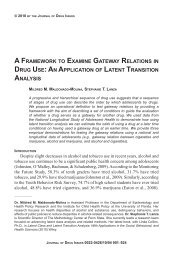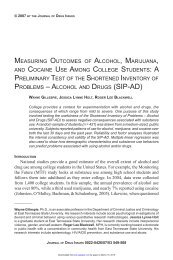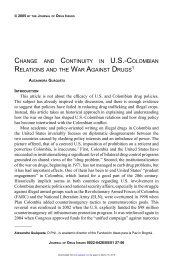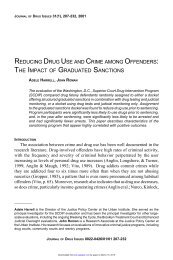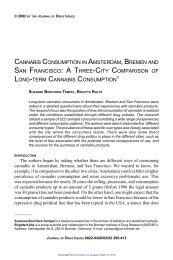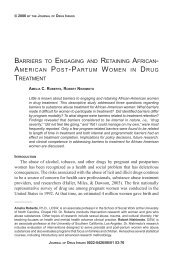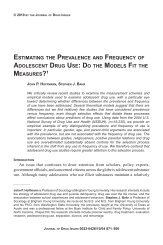a brief history of cannabis policies in spain - Journal of Drug Issues
a brief history of cannabis policies in spain - Journal of Drug Issues
a brief history of cannabis policies in spain - Journal of Drug Issues
Create successful ePaper yourself
Turn your PDF publications into a flip-book with our unique Google optimized e-Paper software.
GAMELLA, JIMÉNEZ RODRIGO<br />
6<br />
See, for <strong>in</strong>stance, the article <strong>in</strong> The Economist: “Spa<strong>in</strong>: Hashish’s Eldorado,”<br />
(September 10, 1984).<br />
7<br />
Available data was <strong>in</strong>adequate, and there were many debates about the extent<br />
<strong>of</strong> the hero<strong>in</strong> crisis. Us<strong>in</strong>g survey data, several authors arrived at very different<br />
conclusions. For <strong>in</strong>stance, <strong>in</strong> a very <strong>in</strong>fluential book, the sociologist Dom<strong>in</strong>go<br />
Comas estimated that by 1984, around 60,000 people were us<strong>in</strong>g hero<strong>in</strong><br />
regularly, mostly by <strong>in</strong>jection. Around 32,000 <strong>of</strong> those were <strong>in</strong> a state <strong>of</strong> deep<br />
dependency (1985, pp. 195-196). Another study, however, based on a national<br />
survey done <strong>in</strong> 1985, established the number <strong>of</strong> regular hero<strong>in</strong> users at 125,000,<br />
<strong>of</strong> whom 103,000 were us<strong>in</strong>g hero<strong>in</strong> one or more times daily (Equipo de<br />
Investigación Sociológica, 1985).<br />
8<br />
The System <strong>of</strong> Information on <strong>Drug</strong> Dependence (SEIT) was a national<br />
monitor<strong>in</strong>g system that counted drug-related emergencies, deaths and demands<br />
for treatment. Accord<strong>in</strong>g to its first complete report <strong>in</strong> 1988, 16,481 persons<br />
began drug dependence treatment <strong>in</strong> public funded facilities; 98 percent <strong>of</strong><br />
these persons were addicted to hero<strong>in</strong> and other opiates; 1.7% were treated for<br />
coca<strong>in</strong>e dependence. Eighty percent <strong>of</strong> patients were male, with mean ages<br />
between 24 and 25 years (SEIT, 1989, pp. 186-187). Hero<strong>in</strong>-related emergencies<br />
where almost as important as treatment demands; 12,000 emergency episodes<br />
were recorded <strong>in</strong> 1988 (SEIT, 1989, pp. 101-105). Three years later, <strong>in</strong> 1991,<br />
over 28,500 people started treatments for hero<strong>in</strong> dependence, over half <strong>of</strong> them<br />
for the first time (15,000). Dur<strong>in</strong>g the same period, fewer than 1,000 persons<br />
demanded treatment for coca<strong>in</strong>e addiction. (OED, 2000, pp. 45-47). In 1997-<br />
1998, admissions to treatment for hero<strong>in</strong> dependence rema<strong>in</strong>ed <strong>in</strong> the range <strong>of</strong><br />
35,000 to 43,000. The portion <strong>of</strong> veteran addicts who had tried a number <strong>of</strong><br />
treatments <strong>in</strong>creased constantly, show<strong>in</strong>g that hero<strong>in</strong> addicts <strong>in</strong> Spa<strong>in</strong> mostly<br />
belong to the same generation. From 1995 onwards, however, coca<strong>in</strong>e-related<br />
demands <strong>in</strong>creased constantly, and <strong>in</strong> 2002 their numbers surpassed those for<br />
hero<strong>in</strong> treatment (OED, 2000, pp. 45-47; OED, 2003, pp. 70-73).<br />
9<br />
The Constitutional Court (Tribunal Constitucional) is the <strong>in</strong>terpreter <strong>of</strong> the<br />
Constitution and has the f<strong>in</strong>al say <strong>in</strong> settl<strong>in</strong>g appeals related to constitutional<br />
law.<br />
10<br />
The “gaps” are also filled with reference to other nonpenal regulations, such<br />
as the lists <strong>of</strong> the UN Conventions (Herrero, 2000, p. 317).<br />
11<br />
Courts may evaluate the evidence <strong>in</strong> disparate ways. The variation <strong>in</strong> court<br />
understand<strong>in</strong>g has affected drugs such as buprenorph<strong>in</strong>e and methaqualone,<br />
and most notoriously ecstasy type drugs (see Gamella & Álvarez Roldán, 1999,<br />
pp. 209-217).<br />
652 JOURNAL OF DRUG ISSUES<br />
Downloaded from jod.sagepub.com by guest on March 15, 2015








